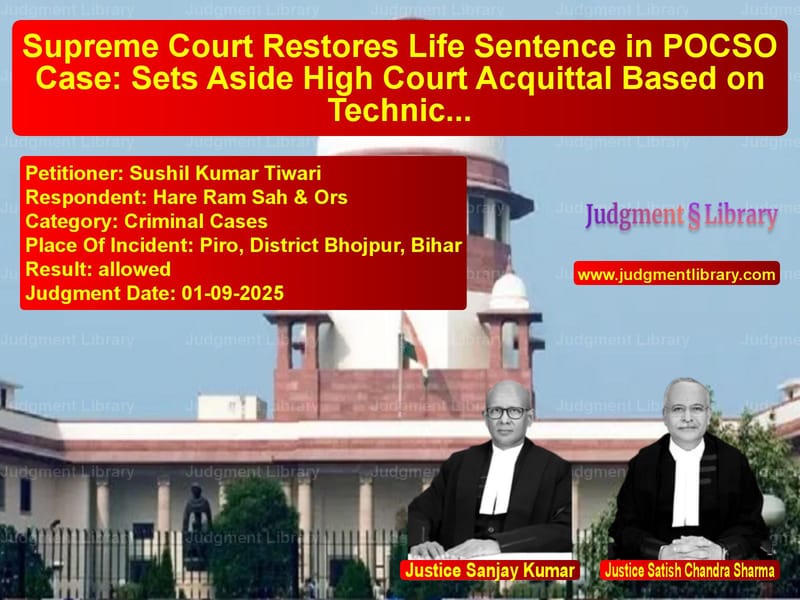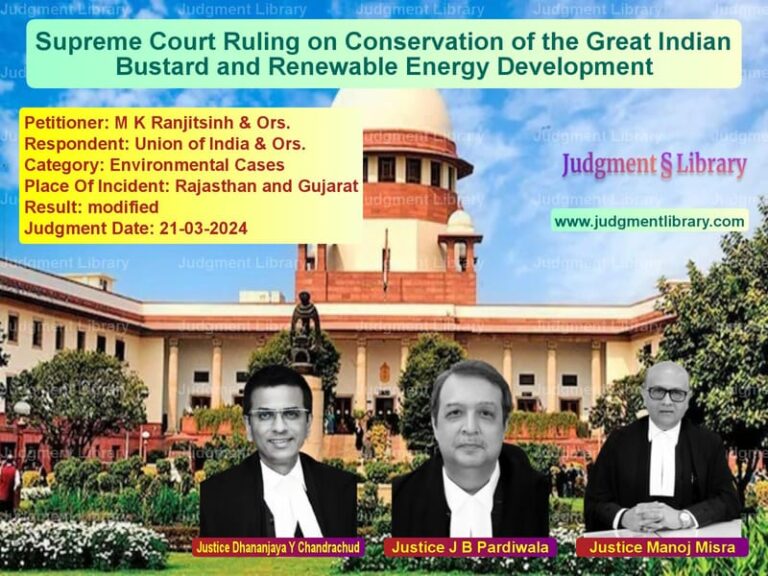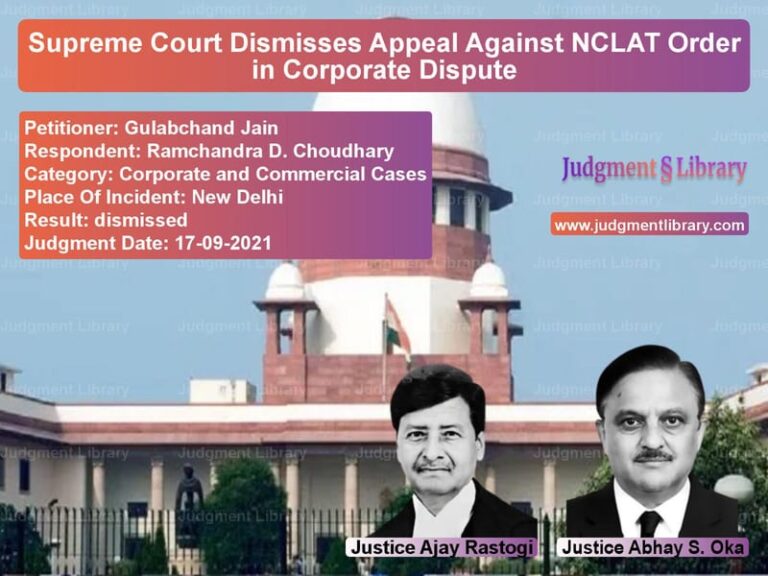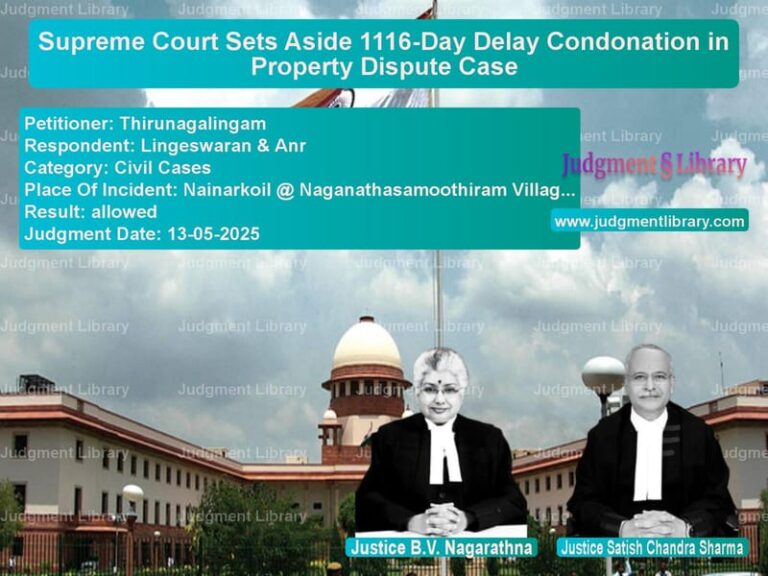Supreme Court Restores Life Sentence in POCSO Case: Sets Aside High Court Acquittal Based on Technical Grounds
In a powerful judgment that underscores the importance of substantive justice over procedural technicalities, the Supreme Court has restored the life imprisonment conviction of two men accused of repeatedly raping a minor girl in Bihar’s Bhojpur district. The case, which highlights the challenges faced by sexual assault victims in rural India, saw the apex court strongly rebuke the High Court for acquitting the accused based on what it termed “misapplication of procedure.”
The heartbreaking story began in 2016, a few months after the festival of Holi, when the victim, then just 12-13 years old, started feeling unwell. Her deteriorating health eventually led her mother to take her to a hospital in Ballia, Uttar Pradesh, where an ultrasound examination on July 1, 2016, revealed a shocking truth – the young girl was three months pregnant. When questioned, the victim disclosed that she had been raped by Hare Ram Sah and Manish Tiwari about 3-4 months earlier, sometime after Holi.
Based on this disclosure, the victim’s father lodged a complaint at Piro Police Station in Bhojpur district on July 2, 2016, which culminated in FIR No. 209/2016. After trial, the Additional District & Sessions Judge cum-Special Judge, POCSO Act found both accused guilty under Sections 376(2) of IPC and Sections 4 & 6 of POCSO Act, sentencing them to rigorous life imprisonment along with substantial fines.
However, in a surprising turn, the High Court acquitted both accused, primarily citing procedural infirmities including improper joint trial under Section 223 Cr.P.C., inconsistencies in proving the victim’s age, lack of proof of pregnancy and abortion, and defects in charge framing. The High Court had observed that “the conviction of the present appellants is not being set aside on the mere ground that the procedure of Section 223 of the Code has not been adhered to but there are numerous laches on the part of the prosecution in proving the case beyond reasonable doubt.”
The victim’s father, represented by learned counsel, challenged this acquittal before the Supreme Court, arguing that the High Court committed grave error in concluding that prejudice was caused to the accused due to non-compliance of Section 223 Cr.P.C. The appellant contended that this ground was never taken by the accused and was examined by the High Court on its own. He further submitted that the victim’s age was established as under 18 years through school transfer certificates, Section 164 Cr.P.C. statements, and medical reports, and that there was no reason to doubt the victim’s testimony, which could form the sole basis of conviction in such cases.
The respondents, however, supported the High Court’s decision, arguing that the investigation was conducted in a casual and negligent manner, causing prejudice to them. They emphasized aspects like age determination, absence of proof of pregnancy and abortion, lack of investigation regarding date, time and place of incidents, and defective charges. They particularly stressed that the joint trial violated Section 223 Cr.P.C. and that incriminating evidence wasn’t properly put to them under Section 313 Cr.P.C.
The Supreme Court, after careful consideration of the evidence and arguments, delivered a comprehensive judgment that addressed each of the High Court’s concerns. On the crucial issue of the victim’s age, the Court noted that while there were slight variations in the recorded age (12-15 years), the minority of the victim was never in doubt. The Court made a significant observation about ground realities: “In rural regions, discrepancies in the educational and identification documents are not unknown and, in such circumstances, the Courts must be sensitive to the ground realities of the society, so as to ensure that the intent of the law is not suppressed and protections created by the legislature reach the intended persons in their right spirit.”
Regarding the date and time of the incident, the Court found the victim’s testimony completely natural, noting that her inability to recollect precise dates was understandable given the circumstances. The medical report corroborated her time-frame, showing she was 3-4 months pregnant when examined. The Court emphasized that “the inability of the victim, a minor girl, to recollect the precise time and date of the offence is completely natural.”
On the proof of pregnancy and abortion, the Supreme Court strongly criticized the High Court for overlooking ample documentary and oral evidence, including medical reports and discharge tickets from hospitals. The Court noted that “this fact was duly proved in the common course of natural events, but the natural events were overlooked.”
Addressing the defect in charge framing, where the Trial Court had mentioned the date of offence as July 2, 2016 (the FIR date) rather than the actual time-frame after Holi, the Supreme Court applied Section 464 Cr.P.C., which states that no finding shall be deemed invalid merely due to error in charge unless it occasions failure of justice. The Court found that the accused were fully aware of the allegations throughout the trial and were never misled by this error.
The most significant aspect of the judgment concerned the joint trial issue under Section 223 Cr.P.C. While refraining from disturbing the High Court’s finding that the offences may not have been part of the same transaction, the Supreme Court emphasized that mere procedural irregularity doesn’t vitiate a trial unless it causes actual prejudice and failure of justice. The Court cited its earlier decision in Nasib Singh v. State of Punjab, noting that “A conviction or acquittal of the accused cannot be set aside on the mere ground that there was a possibility of a joint or a separate trial. To set aside the order of conviction or acquittal, it must be proved that the rights of the parties were prejudiced because of the joint or separate trial.”
The Supreme Court found that the High Court had failed to establish how the joint trial actually prejudiced the accused or caused failure of justice. The Court observed that “It is not a case wherein the joint trial precluded the Respondent Nos. 1 and 2 from presenting a valid defence. It is also not a case wherein separate evidence of the prosecution witnesses could have made any difference to the end result.”
In a powerful concluding section, the Supreme Court addressed the fundamental principle of “beyond reasonable doubt,” observing that “the principle of beyond reasonable doubt has been misunderstood to mean any and every doubt in the case of the prosecution. Often, we come across cases wherein loose acquittals are recorded on the basis of minor inconsistencies, contradictions and deficiencies, by elevating them to the standard of reasonable doubts.”
The Court elaborated that “A reasonable doubt is one that renders the version of the prosecution as improbable, and leads the Court to believe in the existence and probability of an alternate version of the facts. It is a serious doubt which must be backed by reason.” The judgment highlighted the dual responsibility of the justice system: “not only should no innocent face punishment for something that he has not done, but equally, no culprit should manage an acquittal on the basis of unreasonable doubts and misapplication of procedure.”
In its final ruling, the Supreme Court set aside the High Court’s judgment, restored the Trial Court’s conviction and sentence, and directed the accused to surrender within two weeks. The Court’s strong message that “procedure is not supposed to control justice” serves as an important reminder of the fundamental purpose of the justice system – to deliver substantive justice rather than get entangled in procedural technicalities.
This judgment is particularly significant for POCSO cases and sexual offence trials, as it emphasizes the need for courts to be sensitive to ground realities, understand the trauma of victims, and ensure that procedural technicalities don’t become tools for letting actual offenders escape punishment. The Supreme Court’s intervention in this case reaffirms the judiciary’s commitment to protecting the most vulnerable sections of society and ensuring that justice is not denied due to procedural imperfections.
Petitioner Name: Sushil Kumar Tiwari.Respondent Name: Hare Ram Sah & Ors.Judgment By: Justice Sanjay Kumar, Justice Satish Chandra Sharma.Place Of Incident: Piro, District Bhojpur, Bihar.Judgment Date: 01-09-2025.Result: allowed.
Don’t miss out on the full details! Download the complete judgment in PDF format below and gain valuable insights instantly!
Download Judgment: sushil-kumar-tiwari-vs-hare-ram-sah-&-ors-supreme-court-of-india-judgment-dated-01-09-2025.pdf
Directly Download Judgment: Directly download this Judgment
See all petitions in Rape Cases
See all petitions in Juvenile Justice
See all petitions in Judgment by Sanjay Kumar
See all petitions in Judgment by Satish Chandra Sharma
See all petitions in allowed
See all petitions in supreme court of India judgments September 2025
See all petitions in 2025 judgments
See all posts in Criminal Cases Category
See all allowed petitions in Criminal Cases Category
See all Dismissed petitions in Criminal Cases Category
See all partially allowed petitions in Criminal Cases Category







